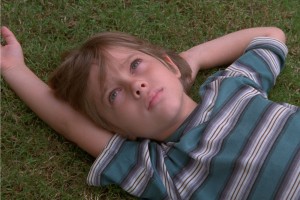Boyhood
Boyhood, 2014, 4 stars
Boyhood is breathtakingly unique
Richard Linklater filmed actors over 12 years
From The Orlando Weekly, July 31, 2014; and Jacksonville Folio Weekly, August 13, 2014
Since the dawn of cinema, directors have tried to capture the passage of time and the aging of actors. First choosing to borrow theatre make-up or cast actors of various ages in the same role, early filmmakers soon learned that the right light and lenses could achieve a realism unobtainable on stage. Advancement in prosthetics, traditional special effects and, ultimately, digital trickery – displayed most memorably in The Curious Case of Benjamin Button – have now made on-screen aging almost real. Almost.
 Despite the brilliance of all those art forms, director Richard Linklater, in a single film, has upstaged all the makeup, CGI and wigs ever thrown at the screen by simply watching and waiting – and filming – over 12 years, in a fashion not entirely dissimilar from the Up documentaries. In 2002, he selected Ethan Hawke, with whom he’s worked on three other movies involving the expanse of time (the “Before” films), to play his story’s father, Mason Sr., while he chose Patricia Arquette for the mother. In the crucial role of Mason Jr., he cast Ellar Coltrane, and to portray Mason Jr.’s slightly older sister, Samantha, he picked his own daughter, Lorelei. Then he filmed, and filmed, and filmed, capturing not just the maturation of his screenplay’s characters, but the aging of real people, thereby creating a fascinating film and, at the same time, conducting a unique and noble experiment – and even crossing the line from fiction into unintended documentary.
Despite the brilliance of all those art forms, director Richard Linklater, in a single film, has upstaged all the makeup, CGI and wigs ever thrown at the screen by simply watching and waiting – and filming – over 12 years, in a fashion not entirely dissimilar from the Up documentaries. In 2002, he selected Ethan Hawke, with whom he’s worked on three other movies involving the expanse of time (the “Before” films), to play his story’s father, Mason Sr., while he chose Patricia Arquette for the mother. In the crucial role of Mason Jr., he cast Ellar Coltrane, and to portray Mason Jr.’s slightly older sister, Samantha, he picked his own daughter, Lorelei. Then he filmed, and filmed, and filmed, capturing not just the maturation of his screenplay’s characters, but the aging of real people, thereby creating a fascinating film and, at the same time, conducting a unique and noble experiment – and even crossing the line from fiction into unintended documentary.
John Lennon wrote, “Life is what happens to you while you’re busy making other plans.” Linklater must agree, because to capture childhood from ages 6 to 18, he’s chosen not to portray many of life’s predictable moments. Instead, he’s selected seemingly random snapshots. By doing so, we don’t always get high drama, but we do get a patchwork quilt of existence. It has some misshapen squares, but when we examine the completed piece, we see truth.
These cinematic squares depict sibling squabbles, stolen peaks at Victoria’s Secret catalogs, a first kiss, a first job and President Obama’s first presidential campaign. Other threads weave deeper, personal visions, such as when Mason Jr. discovers his dad’s flaws and realizes that his mom is stuck in a cycle of doomed marriages. And most fittingly, we see kids attending a Harry Potter film, because those movies, like this one, successfully capture fleeting youth and the aging of children – and the actors who portray them.
Boyhood’s concept may be great, but the finished film falls just short of greatness. Speaking to the difficulty of predicting whether a child will become an effective adult actor, Coltrane and the young Linklater are just passable. Add in some clunky scenes and other average performances, and the film, especially early on, lacks energy and momentum. And by starting the story after Mason Jr.’s parents are already divorced, Linklater robs us of a crucial episode in the boy’s life. Still, when the movie’s 2 hours and 46 minutes are up, we can’t help but look back on Mason Jr.’s youth and examine our own while wondering, as he does, “What’s the point?”
Despite the wrinkles in Linklater’s time tapestry, he has given us one of the most memorable movies of the year, and probably his own masterpiece. Time was clearly on his side, and now it’s on ours, too.
© 2014 Orlando Weekly / MeierMovies, LLC